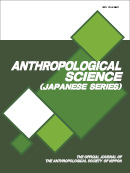Volume 115, Issue 2
Displaying 1-5 of 5 articles from this issue
- |<
- <
- 1
- >
- >|
Review
-
2007Volume 115Issue 2 Pages 73-83
Published: 2007
Released on J-STAGE: December 22, 2007
Download PDF (455K)
Original Articles
-
2007Volume 115Issue 2 Pages 85-95
Published: 2007
Released on J-STAGE: December 22, 2007
Download PDF (871K) -
2007Volume 115Issue 2 Pages 97-107
Published: 2007
Released on J-STAGE: December 22, 2007
Download PDF (729K) -
2007Volume 115Issue 2 Pages 109-125
Published: 2007
Released on J-STAGE: December 22, 2007
Download PDF (1352K)
Book Review
-
2007Volume 115Issue 2 Pages 127
Published: 2007
Released on J-STAGE: December 22, 2007
Download PDF (124K)
- |<
- <
- 1
- >
- >|
